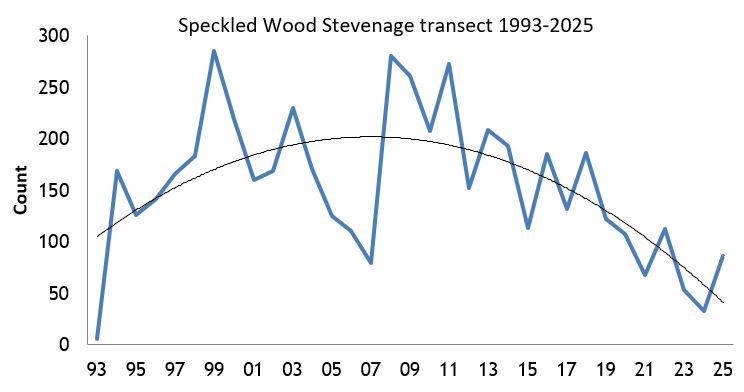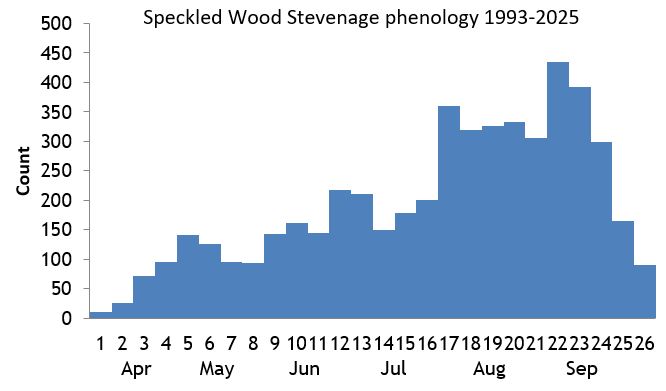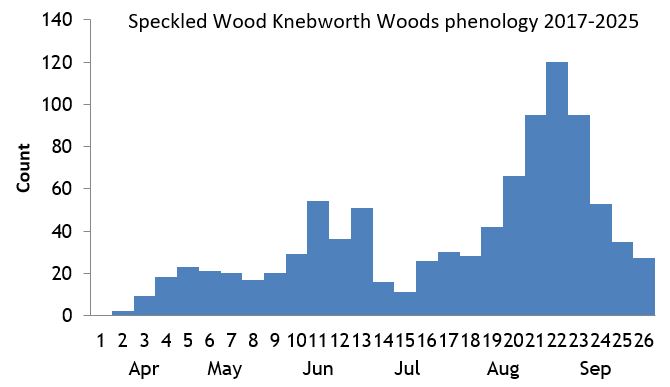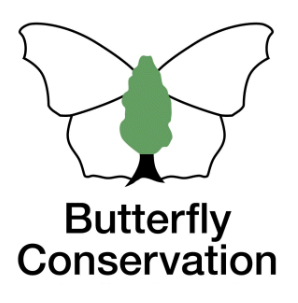Brown Argus
Brown Hairstreak
Chalkhill Blue
Clouded Yellow
Comma
Common Blue
Dark Green Fritillary
Dingy Skipper
Essex Skipper
Gatekeeper
Green Hairstreak
Green-veined White
Grizzled Skipper
Holly Blue
Large Skipper
Large White
Marbled White
Meadow Brown
Orange-tip
Painted Lady
Peacock
Purple Emperor
Purple Hairstreak
Red Admiral
Ringlet
Silver-washed Fritillary
Small Blue
Small Copper
Small Heath
Small Skipper
Small Tortoiseshell
Small White
Speckled Wood
Wall
White Admiral
White-letter Hairstreak
Extinct/rare immigrants
Speckled Wood
Pararge aegeria
General Distribution and Status
The Speckled Wood is a common and widespread species in England and Wales, and expanding in Scotland. In many ways, the butterfly's distribution changes during the last 200 years mirror those of the Comma; it was widespread throughout Britain up until the end of the 19th century when a period of retraction began with distribution becoming more scattered and colonies lost in the south of England (Heath et al.). The 1920s saw expansion in its range and accelerated in the 1940s to occupy many former sites. Habitat changes, for example, cessation of woodland coppicing, have not adversely affected this butterfly due to the butterfly's tolerance to shade. Since 1976 the distribution and abundance at monitored sites have almost doubled although both range and abundance have stabilised in the last ten years or so. In some areas with increased warmth and rainfall, as a result of climate change, there is some evidence that the butterfly has adapted to breed on more open non-woodland sites which are generally drier and cooler (in winter) than woodland sites and may explain some of the expansion in range. Previously, the open areas would have been more vulnerable to plant desiccation and have an adverse affect on larval development and survival (Pateman et al.). In Hertfordshire and Middlesex, it was quite rare at the beginning of the 20th century but numbers generally increased from the 1940s onwards coupled with expansion from the south and west. Since the start of this century, though, numbers have dropped quite significantly, probably as a result of increased woodland management including widening of rides, less favoured by this insect (Wood, 2016, 2018). Interestingly, the highest transect counts now appear in urban London areas.
| United Kingdom | Herts & Middx | |||
| Distribution | 1976-2019 | +53% | 1980-2015 | +215% |
| Average 10-year trend | +9% | 2006-2015 | +8% | |
| 2024 since 2015-19 | +8% | |||
| Abundance | 1976-2024 | +86% | 1980-2015 | -8% |
| 2015-2024 | -7% | 2006-2015 | -32% | |
| 2023-2024 | -21% | 2024 since 2015-19 | -33% | |
UK distribution map
UKBMS Species summary
Habitat Requirements
This species is a woodland butterfly as the name suggests but it can often be seen along hedgerows in the wider countryside as well as gardens in the south.
Larval Foodplants
Cock's-foot Dactylis glomerata, Common Couch Elymus repens in meadows and False Brome Brachypodium sylvaticum in open woodland.
Adult Food Sources
Common Michaelmas Daisy Aster x salignus (82), Buddleia Buddleja davidii (73), Bramble Rubus fruticosus agg. (45), Iceplant Sedum spectabile (31), Common Ragwort Senecio jacobaea (29).
Historical Records
Matthews found the butterfly to 'be fairly common near woods in the neighbourhood of Stevenage' (Gibbs) but by the 1930s it appeared to have become scarce (Foster). The spread from the south-west began in the 1940s as noted above and the species reached Stevenage in that decade when Michael Newlands saw a specimen at Fairview Road, Stevenage on 18 June 1944 (Bowden 1946). Brian Waldock, Michael and David Newlands found one at St. John's Wood on 9 June 1948 (Bowden 1948) but curiously no reports received from the Knebworth Woods area until 1976 when Nigel Agar spotted one at Watery Grove (Sawford). My first record of the butterfly in the area was in 1985 at Monks Wood.
Local Distribution and Abundance
As indicated on the map, the Speckled Wood occurs in every tetrad in the Stevenage area. Whomerley Wood is one of the best places to find it although the butterfly is not as common as it used to be, owing to lack of management of the rides which are now too overgrown and shady. Numbers built up across the area since the late 2000s to reach a peak in 2018 but have reduced steadily since then. Poor weather in 2024 hampered progress even further for this butterfly with abundance lower still and figures suggest the worst year since 2015.

Stevenage (South Fairlands Valley Park) transect 1993-2025
There has been a significant decline in abundance since 2011 which may be attributed to the poor summers in the first half of the decade although the last few dry spring/early summers have not improved matters.

Knebworth Park transect 1996-2010 and 2017-2025
There has been a significant decrease in numbers of this butterfly since the beginning of the century. Loss of suitable habitat is the most likely reason. Curiously very few specimens are seen before the end of May although there are notable peaks at the end of June and end of August which is usual. In 2018, warm weather in May seems to have accelerated development in the larval stage to bring numbers to a peak in early June. Compare with the Stevenage transect phenology chart. Perhaps proportionately more specimens overwinter in the larval stage hence accounting for a later emergence in the spring.

Knebworth Woods transect 2017-2025
Numbers more than doubled in 2018 with most seen in June and the end of August. As with the Knebworth Park transect very few were observed in the early spring. More research is needed to discover why the phenology is different compared apparently to the rest of the county.

Pryor's Wood transect 2000-2022
A significant decrease in abundance of this species since 2003 which was the best year with 48 individuals counted. However, 2021 saw a good recovery with the butterfly seen on a number of occasions.Life History
Earliest date: 15 March 2017 at Great Ashby
Latest date: 18 October 2022 at Watery Grove
The
Speckled Wood produces two generations a year although they overlap because of the extended emergence of the first brood. Those that hibernate as pupae
emerge in April whereas those that overwintered as larvae usually emerge some weeks later. Because of the overlap there are several peaks: usually in
the first week of May, middle of June, late July and late August/early September. Nevertheless, in suitable areas, it may be seen in every week between
late March and early October. Specimens seen in October could be from a small third brood. The 15 March record at Great Ashby in 2017 is the earliest ever
for the TL22 decad. Eggs are usually laid singly on the underside of a leaf of grass. Larvae feed on the leaves. As winter
approaches, some larvae enter hibernation whilst others form pupae attached to a grass stem or leaf. This is the only known British species which
passes the winter in two different stages.
Behaviour/Observation notes
The Speckled Wood has been the subject of many studies regarding its behaviour. Males establish territories mostly in sunny but sheltered spots in woodland and along hedgerows about one or two metres above ground. See below for how variation of markings and body shape affects the butterfly's mate location behaviour.
Variations/Aberrations
The aberrations of this butterfly mostly relate to the extent of the pale markings on the wings. There is much variation in the
colour and number of the pale spots as well as the ground colour and body shape. In the spring, the pale spots are usually larger to reflect the more
open situations in woodlands than later in the summer, and the males spend much time basking in sun-lit spots to defend their territories. The male's
body shape is normally broader at this time of year since its stronger flight muscles enable the male to more successfully fight off intruders and
intercept any virgin females with short quick bursts of flight. The darker males with smaller spots, which appear later in the summer, are more inclined
to patrol in the tree canopy in hot weather. Males possessing four pale spots on their upperside hindwings tend to be perchers whereas those with three
are more likely to be patrollers (Thomas & Lewington).
Find out more on the UK Butterflies website
References

Newton Wood 23 Apr 2019 (spring brood)

Norton Green 10 Aug 2017 (summer brood)

Whomerley Wood 30 Aug 2019

Monk's Wood 11 Jun 2021





